|
|
|
Sort Order |
|
|
|
Items / Page
|
|
|
|
|
|
|
| Srl | Item |
| 1 |
ID:
133819
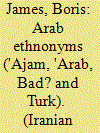

|
|
|
|
|
| Publication |
2014.
|
| Summary/Abstract |
In general terms, the history of the Kurds in the medieval period-or at least those described as being Kurdish in our sources-has attracted relatively little attention within western academia. Moreover, those scholars who have thought to comment on the subject have in general relied on the work of the eminent Russian orientalist Vladimir Minorsky. Hence there has been very little re-examination of the Arabic sources which Minorsky consulted. This article constitutes a first attempt to re-examine some of the "historical orthodoxy" regarding the meaning and nature of the term Kurd in the Middle Ages. More precisely, it aims at questionning the work of those scholars who argue that, due to its ambiguous usage, the term Kurd in the medieval period did not denote an ethnic people. This paper argues that in fact the very ambiguity surrounding the term is indicative of its ethnonymic value and through an examination of the meaning of the term Kurd in this era we can gain a greater understanding of conceptions of ethnic difference in Arabo-Muslim sources.
|
|
|
|
|
|
|
|
|
|
|
|
|
|
|
|
| 2 |
ID:
132312
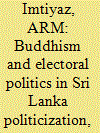

|
|
|
|
|
| Publication |
2014.
|
| Summary/Abstract |
Organized religions often play a significant role in the political affairs of any country when political actors carefully employ them to pursue power. Buddhism is the major religion on the island of Sri Lanka, and often it becomes a powerful symbol for Sinhala-Buddhist politicians. This study examines the interaction between Buddhism and politics in Sri Lanka, and will attempt to examine the religious factors in Sri Lanka's ethnic conflict between the two nations; namely, Tamil and Sinhala. It will examine how the politicization of Buddhism helped Sinhala political elites and leaders in their quest for power, reinforcing religious and ethnic tensions, and finally will discuss some solutions to de-religionize the state structure to help Sri Lanka enjoy the fruits of modernization and democracy.
|
|
|
|
|
|
|
|
|
|
|
|
|
|
|
|
| 3 |
ID:
146344
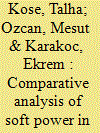

|
|
|
|
|
| Summary/Abstract |
This study explores the relationship between ethnic, sectarian, and religious identities and soft power in the Middle East and North Africa (MENA) region in the immediate aftermath of the Arab Uprisings. Utilizing original public opinion surveys conducted in Egypt and Iraq in 2012, we find that identity-based allegiances play a major role in groups’ choices regarding which countries’ increasing involvement in the region are seen favorably and which countries are seen as an ideal model for the region. Sunnis are likely to view Turkey and Saudi Arabia positively in both regards, whereas Shiites are more supportive of Iran. But our results also suggest that crosscutting cleavages should not be overlooked: Sunni Kurds are less likely to hold positive attitudes toward Turkey and Saudi Arabia. Our findings also show that Copts, a religious minority in Egypt, hold positive attitudes toward the United States and negative ones toward Saudi Arabia and Iran. These findings contribute to both the theoretical literature on soft power and the debates on international competition for influence in the MENA region by emphasizing the role of ethnic and religious identities in shaping attitudes toward international actors.
|
|
|
|
|
|
|
|
|
|
|
|
|
|
|
|
| 4 |
ID:
131950


|
|
|
|
|
| Publication |
2014.
|
| Summary/Abstract |
In a novel approach to studying political mobilization among ethnic Tibetans in China, this article addresses two key questions. First, considering the Chinese state's repressive policies towards Tibetan Buddhism, what role does religion play in fomenting Tibetan political resistance? Second, what implications can be drawn from the changing ethnic demography in Tibet about the conflict behaviour of Tibetans? Using various GIS-referenced data, this article specifically examines the 2008 Tibetan protest movements in China. The main results of our analysis indicate that the spread and frequency of protests in ethnic Tibetan areas are significantly associated with the number of officially registered Tibetan Buddhist sites, as well as the historical dominance of particular types of Tibetan religious sects. Furthermore, our analysis shows that the effect of Han Chinese settlement on Tibetan political activism is more controversial than previously though
|
|
|
|
|
|
|
|
|
|
|
|
|
|
|
|
| 5 |
ID:
133820
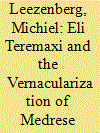

|
|
|
|
|
| Publication |
2014.
|
| Summary/Abstract |
Eli Teremaxi's Serfa Kurmancî has not yet received the critical attention it deserves. It was dismissed by Auguste Jaba as a text of "minor interest," but in fact it is of paramount importance both for the study of the Kurdish language and for the history of Kurdish learning. Not only does it contain the oldest extant detailed remarks on Kurdish grammar, in all likelihood preceding even Garzoni's 1787 Grammatica; it is also among the first examples of Kurdish-language prose writing. The rise of prose texts of learning in Kurdish in the eighteenth century is an aspect of so-called "vernacularization," i.e. the use of a vernacular language for new purposes of written literature and learning. Vernacularization is, this article argues, a crucial prerequisite for the rise of a national language. The article also briefly discusses traces of a similar development in some of Teremaxî's near-contemporaries.
|
|
|
|
|
|
|
|
|
|
|
|
|
|
|
|
| 6 |
ID:
090318
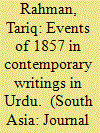

|
|
|
| 7 |
ID:
131475
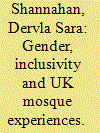

|
|
|
|
|
| Publication |
2014.
|
| Summary/Abstract |
Access to, management and attendance of places of worship often takes gendered forms. Gender imbalances in UK mosques manifests in attendance and management patterns and is reflected in the facilities available. The sense that mosques are perceived widely as 'prayer-clubs for men' (Maqsood 2005: 4-5) is often reflected in the physical spaces and facilities made available to female worshippers, and it must be noted that some mosques do not provide any of the latter at all (Dispatches 2006). Shockingly, a recent survey found that 'women form part of the congregation in [only] half (51%) of the organisations surveyed' (Coleman 2009: 10). Relatedly, UK Mosque management committees privilege male involvement, decision-making and leadership roles, with figures of as few as 15% women in management positions (Asim 2011: 34) and more who 'will simply not entertain the idea' (Asim 2011: 39). Such imbalances reflect the specificities of the UK-religious context (Maqsood 2005) yet, globally, women's mosque involvement appears to be changing far more rapidly than here. This paper explores how gender, religious identity and sexualities interface with women's mosque access, involvement and experiences therein. It draws upon original research with a sample of women, and indicates that inclusivity is an important topic in UK mosques, far beyond gender
|
|
|
|
|
|
|
|
|
|
|
|
|
|
|
|
| 8 |
ID:
131481
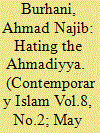

|
|
|
|
|
| Publication |
2014.
|
| Summary/Abstract |
Religious diversity and pluralism is commonly understood within the context of the relation between various religious traditions, not within a single religious tradition. This limitation of the boundary of religious pluralism could overlook the fact that conflict within a single tradition can be bitterer and more disastrous than conflict with other religions. In the last decade, for instance, the Ahmadis in Indonesia have become victims of constant attacks. This article, therefore, intends to study the place of the Ahmadiyya in the context of religious pluralism in Indonesia by answering the following questions: Why was the treatment of the Ahmadis in recent years by Muslims more vitriolic than their treatment of non-Muslims? What is the nature and quality of life for people who have been excluded from a 'normal' religious identity in a time when religious attachment is a necessary fact for that society? Why did the attacks on the Ahmadiyya occur in the present regime, not during the past authoritarian one? This article argues that the charge of heresy issued by Muslim institutions put the Ahmadiyya in liminal status; they are in the zone of indistinction between Muslims and non-Muslims. This makes them vulnerable to persecution since they have been deprived of their rights as Muslims, while their rights as non-Muslims are still suspended. Non-Muslims, particularly ahl al-kit?b (People of the Book), have been accepted theologically in Muslim society, but there is no place of tolerance for heretics. The rise of intolerance in Indonesia parallels the rise of religious conservatism after the fall of Suharto in 1998.
|
|
|
|
|
|
|
|
|
|
|
|
|
|
|
|
| 9 |
ID:
132287
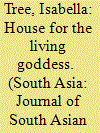

|
|
|
|
|
| Publication |
2014.
|
| Summary/Abstract |
In 2007, during the course of planning the 250th anniversary celebrations of the inauguration of the Kumari Chen-the house of the 'Living Goddess' in Kathmandu's Durbar Square-a new document came to light, which recorded significant alterations made to the building only four years after its foundation. This paper shows how these changes affected the Kumari Chen's identity, transforming it from a building originally designed for royal Hindu Tantric worship to a building with dual purpose, where separate Hindu and Buddhist Tantric worship could take place under the same roof. Taking into account the historical context in which the Kumari Chen was established, this paper explores the purpose for which the building was created by the last Malla king of Kathmandu and identifies motives for the subsequent alterations, shedding light on the relationship between Newar Buddhists and their Hindu king in a time of unprecedented crisis.
|
|
|
|
|
|
|
|
|
|
|
|
|
|
|
|
| 10 |
ID:
133821
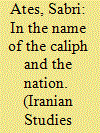

|
|
|
|
|
| Publication |
2014.
|
| Summary/Abstract |
Under the leadership of Sheikh Ubeidullah of Nehri, in the last months of 1880 tens of thousands of Iranian and Ottoman Kurds marched on northwestern Iran and temporarily took control of several cities. This movement, coupled with the response of the Iranian army, resulted in great violence and displacement. Despite its failure, in the limited literature on Kurds this revolt is seen as the birth of Kurdish nationalism. Using extensive and underutilized historical documents-including official correspondence from Iranian and Ottoman authorities as well as British consuls, and day-to-day reports and memoirs from American missionaries active in the region-this project suggests that Sultan Abdulhamid's (Sunni) pan-Islamist agenda, Shi'i-Sunni tensions, the rise of Armenian nationalism, and missionary activities in the region also played significant roles in the formation of this movement.
|
|
|
|
|
|
|
|
|
|
|
|
|
|
|
|
| 11 |
ID:
132278
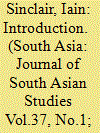

|
|
|
|
|
| Publication |
2014.
|
| Summary/Abstract |
Michael Allen is a pioneering figure in the study of the Newars, the indigenous people of Nepal's Kathmandu Valley. Allen carried out his main fieldwork in Nepal between the mid 1960s and late 1970s and enjoyed a successful academic career, twice acting as head of the Department of Anthropology at the University of Sydney between 1985 and 1991. While Allen is also well known for his studies of cults in settings as disparate as Vanuatu and Ireland-and after retirement was honoured by colleagues for his 'commitment to the comparative method' with a festschrift published in 2001 -his work on the Newars remains especially vital and worth re-visiting. The population, environment and government of Nepal have all changed greatly in recent decades; at the same time, the significance of Newar religion is beginning to be more widely appreciated. In this special section of South Asia we re-examine some of the rituals, institutions and traditions treated by Allen in four new papers, contributed by scholars around the world.
|
|
|
|
|
|
|
|
|
|
|
|
|
|
|
|
| 12 |
ID:
132014
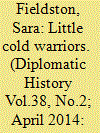

|
|
|
|
|
| Publication |
2014.
|
| Summary/Abstract |
During the two decades following World War II, American voluntary agencies including Christian Children's Fund, Foster Parents' Plan, and the Save the Children Federation ran child sponsorship programs that allowed American' foster parents' to send funds and exchange letters with youngsters in war-torn and poverty-stricken countries around the world. These programs were at once humanitarian gestures and political projects. American sponsorship agencies sought to forge international friendships that would support the United States' political alliances and mold children into strong democratic citizens who would join the fight against communism. Enlisting familial ideals in the service of U.S. foreign policy, American child sponsorship agencies rendered love itself a powerful Cold War weapon.
|
|
|
|
|
|
|
|
|
|
|
|
|
|
|
|
| 13 |
ID:
132283
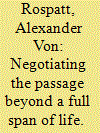

|
|
|
|
|
| Publication |
2014.
|
| Summary/Abstract |
Among the rich heritage of medieval forms of Tantric Buddhism and Hinduism surviving among the Newars of the Kathmandu Valley is a unique series of elaborate old age rituals that are performed upon the attainment of a particular age. Drawing upon the vocabulary of planetary appeasement and other birthday rituals of life-cycle sacraments and of dh?ra?? practice, they serve to protect and sanctify the celebrants and prolong their life. After offering a comprehensive overview of these rituals that registers local variations, this paper probes into their origins and function and, in the process, pays particular attention to the intricate ways in which the Buddhist and Hindu versions of these ceremonies relate to each other.
|
|
|
|
|
|
|
|
|
|
|
|
|
|
|
|
| 14 |
ID:
132080
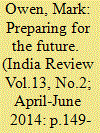

|
|
|
|
|
| Publication |
2014.
|
| Summary/Abstract |
In his 1997 analysis of the history of Tibetan and Chinese relations (The Snow Lion and the Dragon), Melvyn Goldstein advised in his concluding chapter that Tibetans were unlikely to indefinitely put up with the Chinese occupation of Tibet without resorting to violence. However, despite continuing speculation, more widespread or sustained campaigns of violence have largely failed to materialize. The principle objectives of this study are to establish why the scale of violence that Goldstein warned about has so far failed to emerge; and to assess whether existing evidence supports or undermines claims that violence may in the future emanate from Tibetan exile communities in India. It will be argued that previous analyses have been premised on a relatively narrow assessment of the situation and context, and that a more informed and nuanced evaluation of the potential for future violence requires comprehensive analysis of a much wider range of factors.
|
|
|
|
|
|
|
|
|
|
|
|
|
|
|
|
| 15 |
ID:
123760
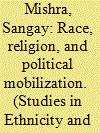

|
|
|
|
|
| Publication |
2013.
|
| Summary/Abstract |
In the days and months following 11 September 2001, South Asians in the United States were lumped together and racialized as 'outsiders' and 'threatening'. The lumping of South Asians existed alongside their differential targeting based on particular religious identities such as Hindu, Muslim, and Sikh. The religious identity not only shaped and calibrated the racial hostility against different South Asian groups but also framed their responses to racial attacks. The primacy of religious identities in framing the group response to racial hostility made it difficult to build broader panethnic solidarity, thereby challenging the existing understanding of the dynamics of panethnic identity formation and mobilization. The foregrounding of religious identity by different South Asian groups was, in fact, in broad consonance with the multicultural institutional and ideological framework that provides institutional and discursive avenues for the deployment of exclusive and immutable identities.
|
|
|
|
|
|
|
|
|
|
|
|
|
|
|
|
| 16 |
ID:
132269
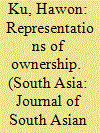

|
|
|
|
|
| Publication |
2014.
|
| Summary/Abstract |
This article explains the changes found in patas (cloth paintings) depicting Shatrunjaya, which were produced for Shvetambara Murtipujak Jains during the nineteenth century in Gujarat. These patas differed from earlier tirtha patas in that they were much larger and depicted Shatrunjaya as the central subject matter. They were also meticulous in depicting the topographical and architectural features of the site, and included Palitana, the adjacent town ruled by the Hindu Thakur. The emergence of the site as a centre for Jain pilgrimage, as well as changes in Jain perceptions of the site, led to these transformations
|
|
|
|
|
|
|
|
|
|
|
|
|
|
|
|
| 17 |
ID:
131905
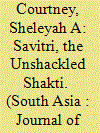

|
|
|
|
|
| Publication |
2014.
|
| Summary/Abstract |
In Hindu cosmology and life-worlds, women are described as being Shaktis, personifications of cosmic feminine power or shakti. However, the shakti of Hindu widows of all ages, because it is no longer directed into reproduction, is feared as being rampant, likely to incur disgrace, polluting and dangerous. Hence, widows, deemed culpable of having failed in their primary wifely duty of protecting and preserving the health and lives of their husbands, are often ill-treated in an attempt to weaken and disarm the reservoir of power that they continue to embody. This article focuses on a case study of a young widow, Savitri, who strove to support her children and maintain her self-regard in the face of frequently-violent hostility from her neighbours due to her creative yet subversive circumvention of the religio-cultural prescriptions and proscriptions her widow status demanded. The article explores social and psychological processes through which identification with the great Hindu goddess, Mahadevi, might enable marginalised widows to sustain the self-experience of being imbued with power-shakti-like their goddess is, albeit within the constraints of the wider community.
|
|
|
|
|
|
|
|
|
|
|
|
|
|
|
|
| 18 |
ID:
180266
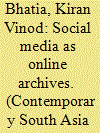

|
|
|
|
|
| Summary/Abstract |
In this ethnographic study I demonstrate how students, teachers, and parents use the affordances of social media platforms to insert religious identities within educational spaces, learning experiences, and classroom interactions. This study was conducted in three schools in tier-I cities of India. The aim of this study was to examine the role of parents and teachers in socializing young students to perform their religious identities while engaging with both educational content and their classmates from a different religious community. In this paper, I argue that social media networks are largely used by individuals to reactivate the existing discursive-discriminatory practices which populate the already dense and politicized mediascapes in cities of India.
|
|
|
|
|
|
|
|
|
|
|
|
|
|
|
|
| 19 |
ID:
132514
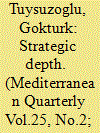

|
|
|
|
|
| Publication |
2014.
|
| Summary/Abstract |
The change in Turkish foreign policy in the twenty-first century's second decade has its origin in the approach referred to by Turkish foreign minister Ahmet Davutoglu as Strategic Depth. Because it aims to give Turkey status as a Eurasian power, this approach has been described as neo-Ottomanism, referencing the geographic extent of the Ottoman Empire. Because of its intrinsic pragmatism and the geographical region that is its focus, Strategic Depth has been influenced by Eurasianist thought in Russia. But the Strategic Depth approach differs from Russian Eurasianist ideas because it refuses to place itself in conflict with Western civilization and instead positions Turkey as a bridge between Western and Muslim civilizations. To this extent, Strategic Depth may be described as a conservative interpretation of Turkish Eurasianism.
|
|
|
|
|
|
|
|
|
|
|
|
|
|
|
|
| 20 |
ID:
132272
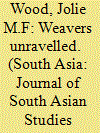

|
|
|
|
|
| Publication |
2014.
|
| Summary/Abstract |
A comparative study of mobilisation by two lower-class occupational groups in Varanasi, India, presents a puzzle: one group, the boatmen of the Mallah community, have successfully formed and sustained several associations to promote boatmen's occupational interests, whereas another group, the handloom weavers of the Ansari community, have no self-formed, durable, active associations. This paper argues that transformation and decline of the weaving industry and significant class divisions within a community that continues to be highly marginalised have left the handloom weavers particularly vulnerable and pose steep challenges to self-organisation.
|
|
|
|
|
|
|
|
|
|
|
|
|
|
|
|
|
|
|
|
|